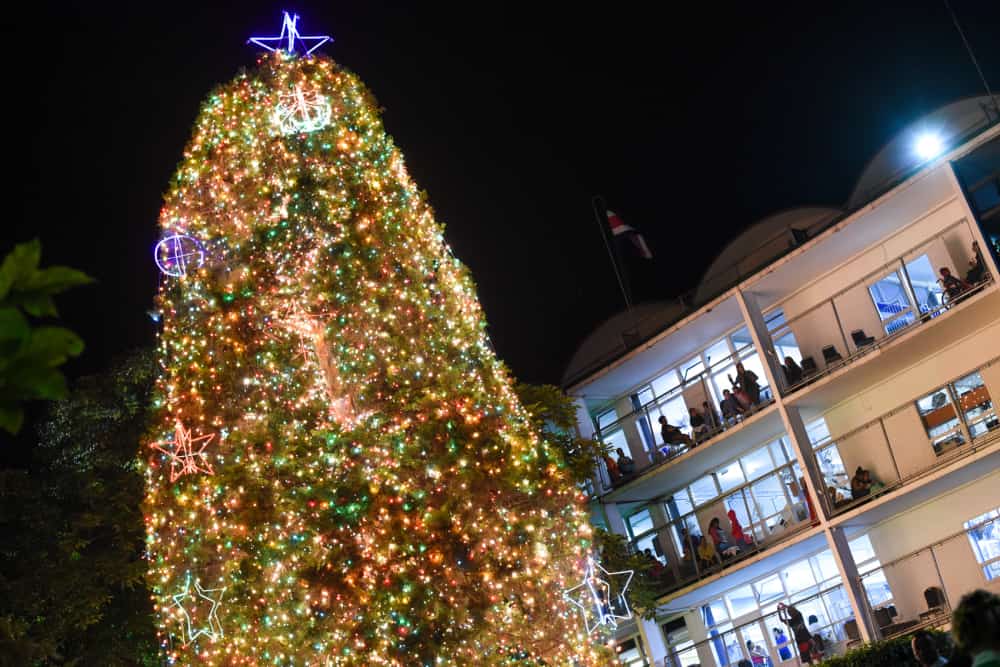Customs change and evolve over time, and even such standards as Christmas get nudged by new influences so that the holiday scene changes over time. Even the most durable of all Tico Christmas customs, the portal, or nativity scene, has undergone changes over the years since it was brought from Spain in the colonial era. This custom, with Mary and Joseph, a donkey and a cow sheltered in a stable, cave or shoe-box house, is still the center of Christmas in Tico homes.
It may be a humble dwelling on the floor or corner table, or an elaborate scene that takes up half the living room and includes lana or moss, colored sand, plants, shepherds, sheep and angels. During the holiday season it’s customary for family and friends to get together for a rosary to the Christ child in front of the portal, followed by refreshments and a good time. In former times there were rosaries every night, which kept Christmas going until February.
In recent years, family ingenuity and creativity have added twinkling lights, moving parts, waterfalls, photos of family members, ornaments and figurines to the portal, and some communities hold “living” portales, with neighbors playing the parts of the Holy Family while the rosary is recited and villancicos (carols) sung.
Midnight Mass, called Misa de Gallo because it ends around the time the roosters crow, is part of Christmas, and it is at midnight, while everyone is at church, that Jesus makes his appearance in the cribs of the nativity scenes in homes across the land, leaving gifts for the children.
Recent years have seen a revival of an old custom, los pastorcitos. In the week before Christmas, children dressed as shepherds, Joseph and Mary visit homes asking for room for Mary to have her baby. Naturally they are invited in, and prayers, songs and treats follow.
Tamales are another must for a Tico Christmas. This custom comes from the region’s indigenous, who celebrated their holidays with cornmeal patties stuffed with locally grown delicacies. Spanish colonists adopted the custom but added their tastes, which soon differed by country, region and family. A Mexican or Peruvian tamal differs from a Tico tamal, and Limón’s differ from Guanacaste’s. It’s still a part of Christmas for the whole family, men and women, to gather around the table, assembling a hundred or more tamales to serve and eat.
Christmas toys for the children first became popular in the 1800s, when German merchants attracted by the coffee boom set up shops with toys and other wonders from Europe. But homemade toys prevailed for most children and included oxcarts and oxen made from corncobs and sardine cans, dolls, balls, tops and marbles.
Some old traditions are gone and not missed. The holiday season used to start on Dec. 8, the Feast of the Immaculate Conception, a holy day for Catholics, and was celebrated with fireworks and firecrackers. This custom became part of Christmas and New Year festivities, causing many permanent injuries, and is now prohibited.
Over the years new customs have joined the old. The straw deer sold in markets and street bazaars are Costa Rican inventions that are now part of home decorations. They come in all sizes and can be decorated with ribbons and bells. The gritería, or “shouting,” was introduced by Nicaraguan immigrants who consider Dec. 8, the Immaculate Conception, part of the holiday season. Friends and neighbors greet each other by shouting, “¿Qué es la causa de tanta alegría?” and are answered by “La concepción de la Virgen María.” (“What is the cause of such happiness? The conception of the Virgin Mary.”) This is followed by refreshments and good feelings. Griterías on Dec. 8 are now seen around the country.
New Year’s comes in Costa Rican “summer” and is out in the open. In rural areas, it’s a fogata or outdoor fire for cooking sausages or meat to nibble on all evening, along with tortillas and a food-laden table. In urban areas, parties or dinners in homes or recreation areas are more common. At the stroke of midnight, each person picks out 12 grapes, one for each month of the year, and between biting into grapes, hugs and kisses, everyone wishes each other a feliz año nuevo. Then it’s time to watch the panorama of colorful fireworks as villages and barrios across the country celebrate the New Year.







